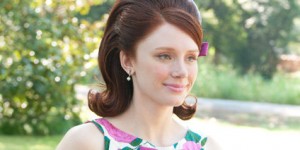Bryce Dallas Howard Goes Back in Time in ‘The Help’ zoomermag.com Movies PEOPLE Tuesday, August 9, 2011 By Richard Crouse
 Bryce Dallas Howard broke one of acting’s cardinal rules when she took on the role of Hilly Holbrook, the socialite segregationist in the film adaptation of Kathryn Stockett’s best selling book The Help. It’s always said that an actor cannot judge the character they are playing. Doing so erases any chance of finding the character’s humanity.
Bryce Dallas Howard broke one of acting’s cardinal rules when she took on the role of Hilly Holbrook, the socialite segregationist in the film adaptation of Kathryn Stockett’s best selling book The Help. It’s always said that an actor cannot judge the character they are playing. Doing so erases any chance of finding the character’s humanity.
“I think they say that for a reason,” she said in a recent interview in Toronto. “I didn’t listen and I did judge her and it was really hard for me to create a real human being for a very long time. It wasn’t until just before shooting that a few things pieced together in my head that made me say, ‘Oh man, this is why she is this way. I can play that. I can play that person.’”
“That person” is the villain of the piece. Set in the weeks and months leading up to the 1963 death of African American civil rights activist Medgar Evers, The Help is the story of a young writer (Emma Stone) who goes against convention—and Hilly, the town’s most outspoken racist—to tell the stories of the settlement’s African-American maids (Viola Davis and Octavia Spencer).
“She’s the character you love to hate [in the book] and I was really excited to play her,” she says. “But then I got to Mississippi for rehearsals and I realized, ‘Oh my gosh, I can’t play a kind of Cruella de Vil version of this woman.’
“This is a character based on not just several women of the time, but the majority of women, and if I didn’t get into her psychology then I was not really portraying the devastating honesty of the people at that time. So I had to get how she ticked.”
Shooting in Greenwood, Mississippi helped her find the character.
“Greenwood, Mississippi happens to be a really well persevered town,” she said. “When you are there the aesthetics of what you are surrounded by is so out of the ordinary because you really feel like you are walking around in the 1960s. The houses look exactly the way they did back then. To the eye it is really beautiful, and I think that was captured in the film, but making this movie and shooting there was eerie because it felt like, while the people were so great and embraced us, aesthetically you felt like you were in a place where nothing had changed.
“Then of course, if you know the history of that era, I mean, Greenwood, Mississippi, in particular, was really the hotbed of the civil rights movement. It’s where the White Citizen’s Council was. Emmett Till was a young boy who was murdered by a group of white men, which was kind of in a way the beginning of the civil rights movement.
“You couldn’t forget that. It made everything extremely real to all of us. If we were shooting in a soundstage in Los Angeles it would have been easier to escape at night or in between takes, whereas shooting there we couldn’t escape what the movie was about.”
Playing the prejudiced Hilly as a combo of “queen bee” and “power hungry woman with a duplicitous nature,” Howard was struck by the immediacy of the film’s story of racism and segregation.
“This was just my parent’s generation,” she says. “That was so recent. On the one hand it is great to see how far we’ve come but we have to remind ourselves that we are very, very close to it and can easily slip back into that mentality.
“I have a four-and-a-half year old son and I’m pregnant now and I think about the things that my children will grow up and say, ‘I can’t believe that was an issue.’ My prayer for myself is that I’m on the right side of history. That I can say, I did something, that I contributed to the evolution of my country.”
